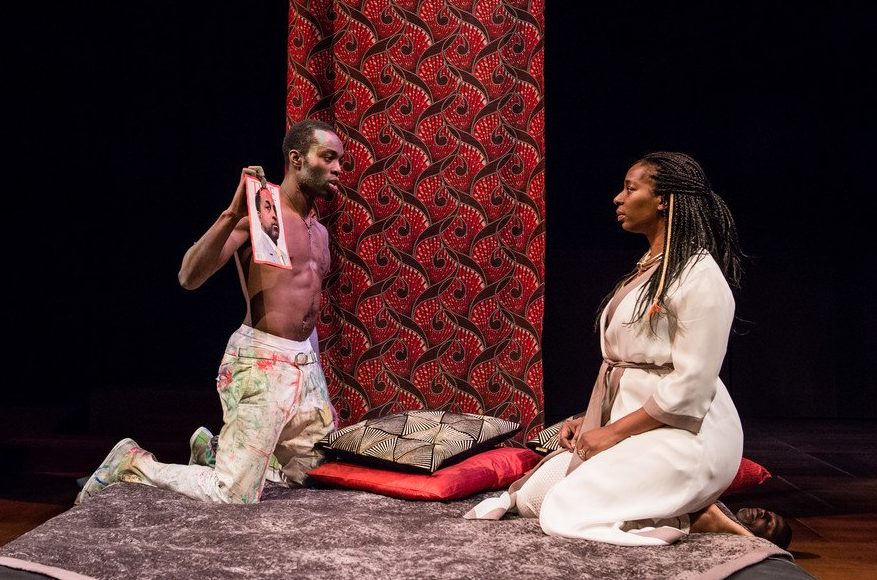A university graduation. Crash. A funeral procession. Crash. A marriage ceremony. Blackout. It is in this stylish sequence of tableaux that the RSC’s Hamlet bursts into vibrant, electric life. On tour for over two years since its original run, this production is permeated by the same swagger throughout. Loud, epic and bright, there is never a moment when the drama sells itself short.
Hamlet is a play that we might often associate with a dark palette of greys, browns and blacks, but it is clear from the offset that Simon Godwin intends to flip the tables on such a sombre and, indeed, clichéd theatrical language. The yellow set is bathed in a warm red light and a long Kente-cloth hangs at the centre. This is an African Hamlet and, in its vision, the production defies all expectations its audience might have about the best way to stage the most difficult play in the English language.
Paapa Essiedu as the tormented prince matches the décor in his vitality and energy. An affable, witty and boyish Hamlet, he often finds himself replacing ‘poor Yorick’ as the designated fool. He mocks the court-figures who surround him, impersonating them, playing tricks on them and guffawing at their interjections. Though we may forget it due to how rarely such humour is drawn upon, this tragedy does, undeniably, have its own share of jokes. With this production, we have the rare occurrence of an auditorium echoing with laughter until the last few scenes.
Draped in a paint-stained suit, Godwin’s Hamlet becomes a colorful trickster figure. It is only at the end of the first half that his patterned garments seem to acquire a new meaning. As canvasses inspired by Basquiat descend from the flies, we suddenly realize that all this bravado, violent theatricality and colour are simply another part of his confusion and torment: a creative urge unsure of how to express itself, soon to transform into destructive capability. Indeed, in one particularly disturbing moment in Hamlet’s bedroom, Essiedu cruelly rubs paint onto Ophelia; he is holding her prostrate on the floor. Language and meaning are at odds. This is simultaneous creativity and destruction. To be or not to be.
The clever Basquiat comparisons struck me as particularly perceptive. Like that artist, currently undergoing an overdue cultural resurgence thanks to the recent Barbican retrospective, Hamlet is a figure who expresses an inner life through ‘suggestive dichotomies’. He is a character torn between humour and sobriety, light and dark, sane and insane. These contradictions are what make him such a difficult personage to realise on stage. Even Essiedu occasionally seems swamped by what this production demands of the role, despite the highly commendable energy he brings. He maintains a spark until the very end of the play, but perhaps this sustained joviality is, in fact, part of the problem in his conveyance of the tragic hero.
The Basquiat influence also helps us to make sense of Hamlet’s position within the complex cultural backdrop of this production. The programme draws parallels between Hamlet and Kwame Nkrumah, Ghana’s first president, who, in 1949, returned to Africa after conducting his studies in England and found himself mired in existential crisis. In this version, Hamlet returns from an American university: Wittenburg, Ohio. Caught between two continents, both Essiedu’s Hamlet and Nkrumah cannot help but feel a crushing sense of personal disorientation amidst external instability. These are the ‘mimic men’ that Homi Bhabha speaks of, trapped in a liminal space between cultures. Basquiat clarifies this link. Sitting comfortably beside Hamlet and Nkrumah, his art constantly searches for union between African and American ideas, symbols and stories. These allusions provide a productive and original take on the psychological impetus for Hamlet’s behaviour.
Whilst African aesthetics are employed in this production, however, they come refreshingly free from the baggage of colonial history. The fact that the names are not changed and the onstage kingdom is still called Denmark even creates the impression that we are observing a world in which imperial roles have been exchanged. Fortinbras is seeking ‘Lands/ So by his father lost’. But are these the colonies lost in the struggle for independence? Or inversely, are they European nation states invaded by the West-African conqueror, King Hamlet? If the latter is the case, the show might almost be considered afro-futurist in its interpretation and design.
Buffeted by strong performances elsewhere, notably Lorna Brown as Gertrude and a doddering Polonius played with great wit by Joseph Mydell, this production whizzes along. Whilst the morose mood of the piece in the second half negates much of the lightness of the first, and in the process lowers the energy, the show never enters the realm of boredom. This is no doubt helped by the African drumming that periodically features. In the fencing scene, this percussion reaches a crescendo, reverberating through the audience: every hair stands on end. It is truly magical.
This, like many moments, is a reminder of how important it is to bring different influences to bear on our classic texts. In an interview with black creative Euton Daley conducted by Cherwell last term, we discussed the idea that diverse casting does not necessarily equate to representation or a meaningful attempt to engage with different cultural experiences. This production however is not just, as Daley put it, ‘black people doing Shakespeare’. It takes seriously the world it represents and brings a whole new reading to the text. For these reasons, although it may not be perfect, this Hamlet is both innovative and important.
RSC’s ‘Hamlet’ is onstage at London’s Hackney Empire, between 6 and 31 March 2018.



